How to Measure Brand Performance: Metrics to Track, Strategies to Leverage, and Optimization Tips
Understand how to effectively track brand performance by discovering the top metrics, strategies, and tools you should pay attention to.


When it comes to measuring brand performance, I know firsthand how easy it is to get buried in endless streams of numbers and dashboards.
Over the years, I’ve learned that having a clear, expert-backed process for analyzing data is what truly makes the difference.
With the right framework, I can confidently track progress, spot issues early, and focus my team’s efforts where they’ll have the greatest impact.
Here’s the approach I rely on—refined through top industry advice and real-world experience—to keep performance measurement sharp and strategic.
Key takeaways
-
What does brand performance imply? Brand performance goes beyond clicks and conversions—it reflects how your brand is perceived, remembered, and trusted across channels, revealing both its emotional and commercial impact.
-
What's the difference between content and brand performance? While content performance measures how individual assets perform tactically, brand performance offers a strategic, long-term view of how your brand is resonating, evolving, and building equity over time.
-
What type of data should you track? To measure brand performance effectively, track metrics across awareness, engagement, perception, loyalty, authority, and competitive standing to understand both audience reach and brand impact.
-
What are some strategies that can help with brand performance optimization?
-
What are some helpful tools for measuring brand performance? Tools like Socialinsider, Mention, Ahrefs, and HubSpot help you monitor brand visibility, sentiment, content effectiveness, and customer behavior across platforms.
What are brand performance indicators?
Brand performance indicators (BPIs) are metrics used to measure how a brand is performing across various channels, like its website, social media platforms, sales channels, and more.
From brand awareness, brand recollection, brand loyalty to more revenue-related business goals, measuring brand performance implies a lot of data points, each prioritized by what abusiness focuse on a particular moment.
Here’s how Chelsea Frank, Social & Digital Marketing Manager at Mettlestate explained them:
Brand performance indicators are your brand’s pulse check.
They measure how your brand is doing, both in the market and in the minds of your audience. That includes everything from awareness, reach, and engagement to sentiment, trust, and customer loyalty.
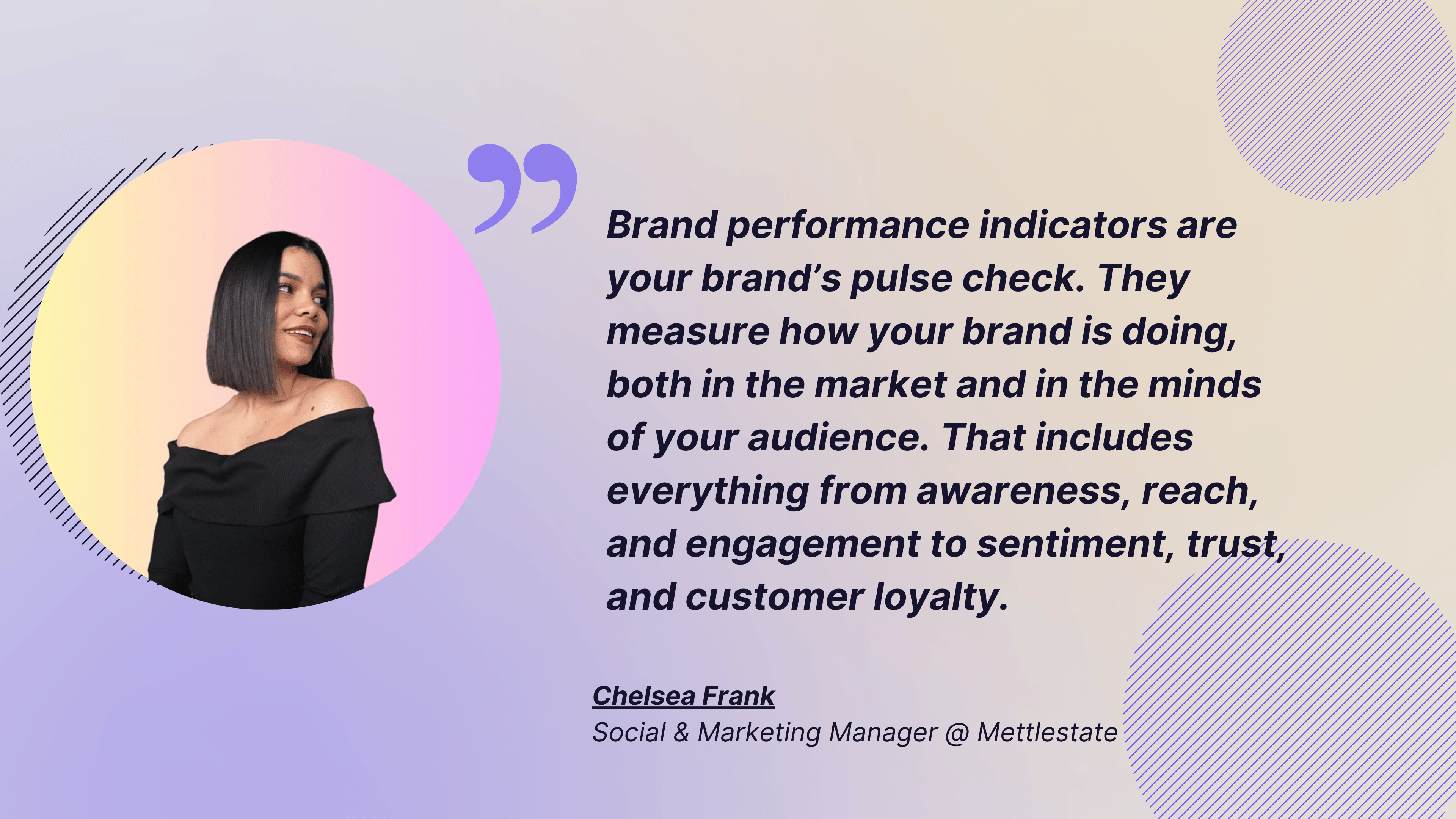
And Jessica Mann, Brand Growth Strategist adds:
Brand performance indicators show how effectively a brand is growing both emotionally and commercially. I want to see how the brand is being perceived to our intended audience, if it’s being remembered, and if there there was enough motivation to take action.
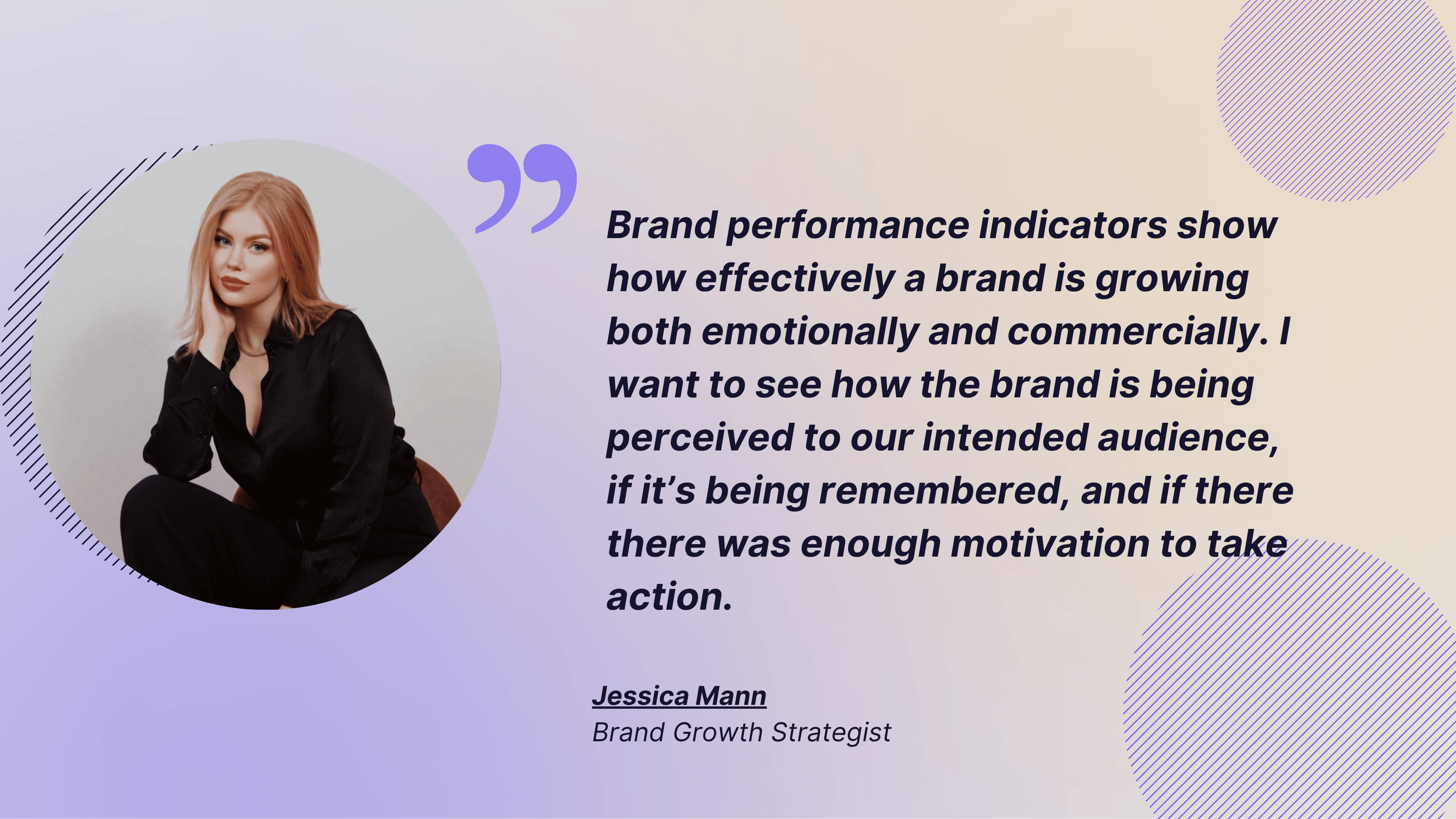
So, what should you be focusing on? Let’s dive in!
What does brand performance measurement imply?
Shortly put, according to Renée Shaw, Brand & Social at tl;dv:
Brand performance implies a deeper understanding than just conversion / clicks. It speaks to cultural fit, resonance, reputation. Things that are more human and nuanced.
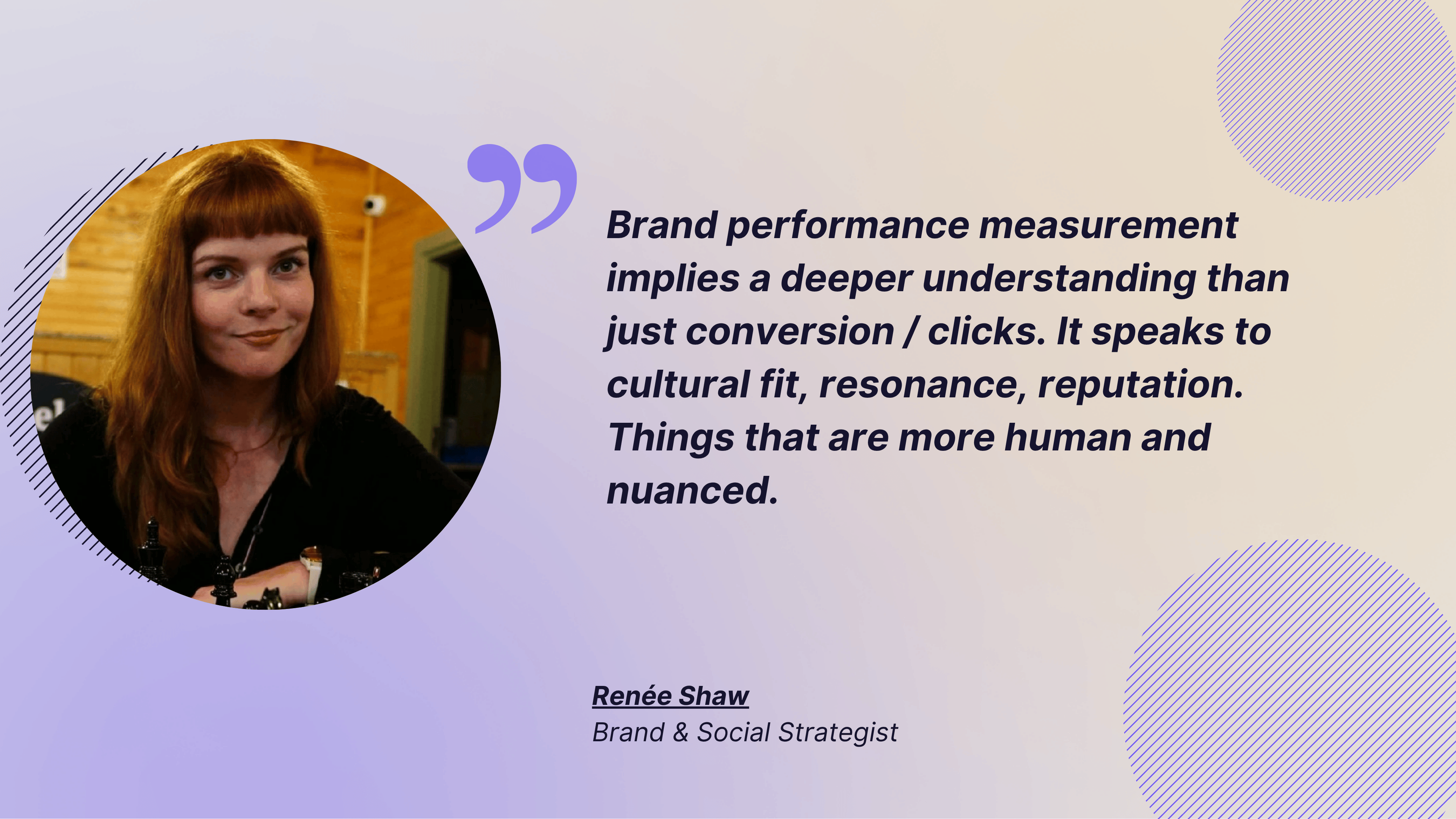
Brands that are measuring their overall performance are taking a strategic approach to their branding strategy that can help set them up for success in the future.
When interviewing her, Chelsea told me that:
Measuring performance indicates that you are willing to change, evolve, and remain accountable to the story your brand is telling, as well as consciously creating something that is not only visible but also valuable.
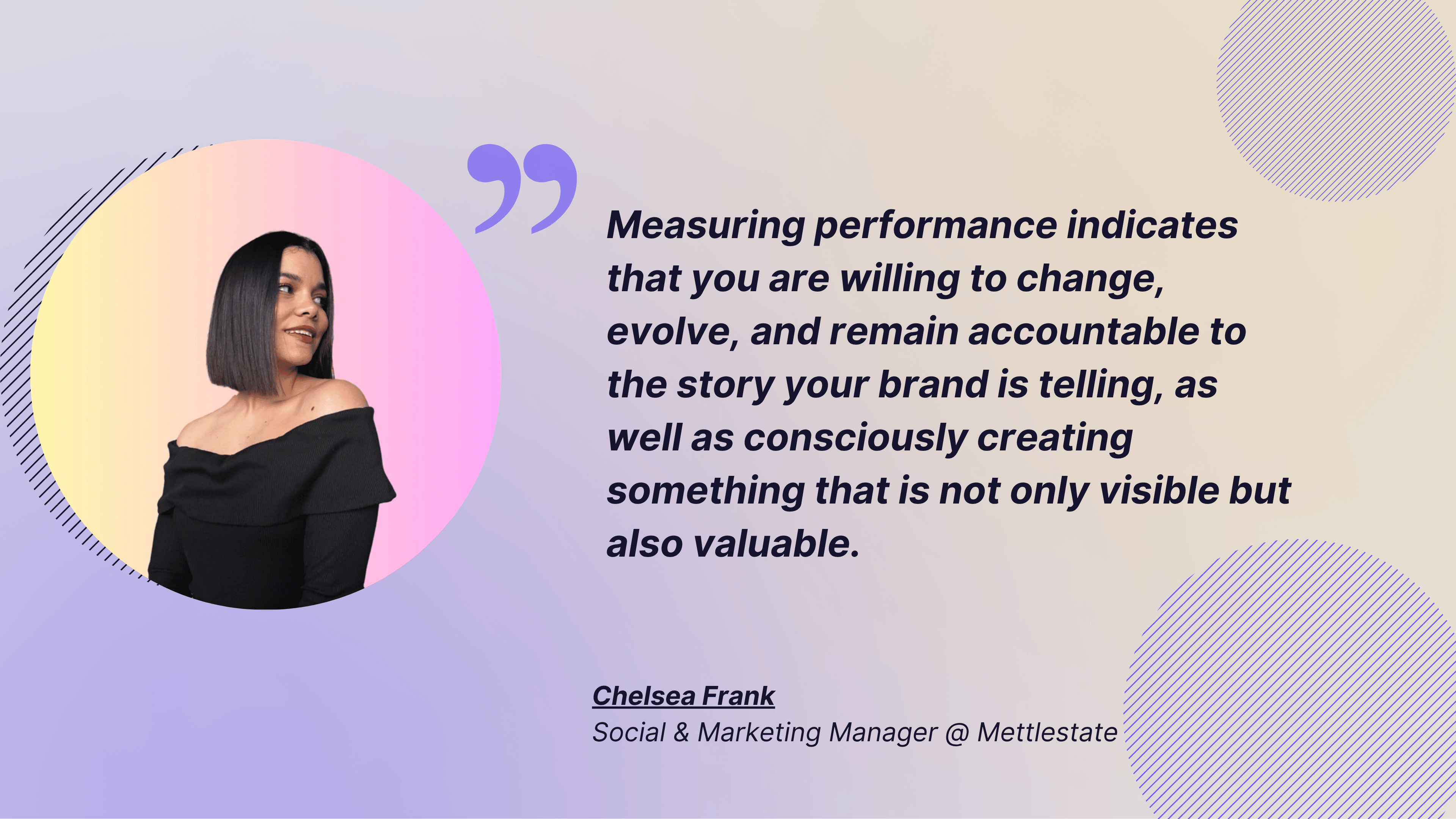
Measuring your brand performance gives you insight into data like:
- How your audience perceives your brand
- Your brand's overall reputation
- Where you stand within your market
- Your brand’s health and equity
- How are your marketing efforts doing
And Jessica adds:
With info like that, you can look into if the messaging is actually landing and identify any spikes in purchase intent. At the core though, brand performance is going to dive into key checkpoints for brand health from a long game perspective.
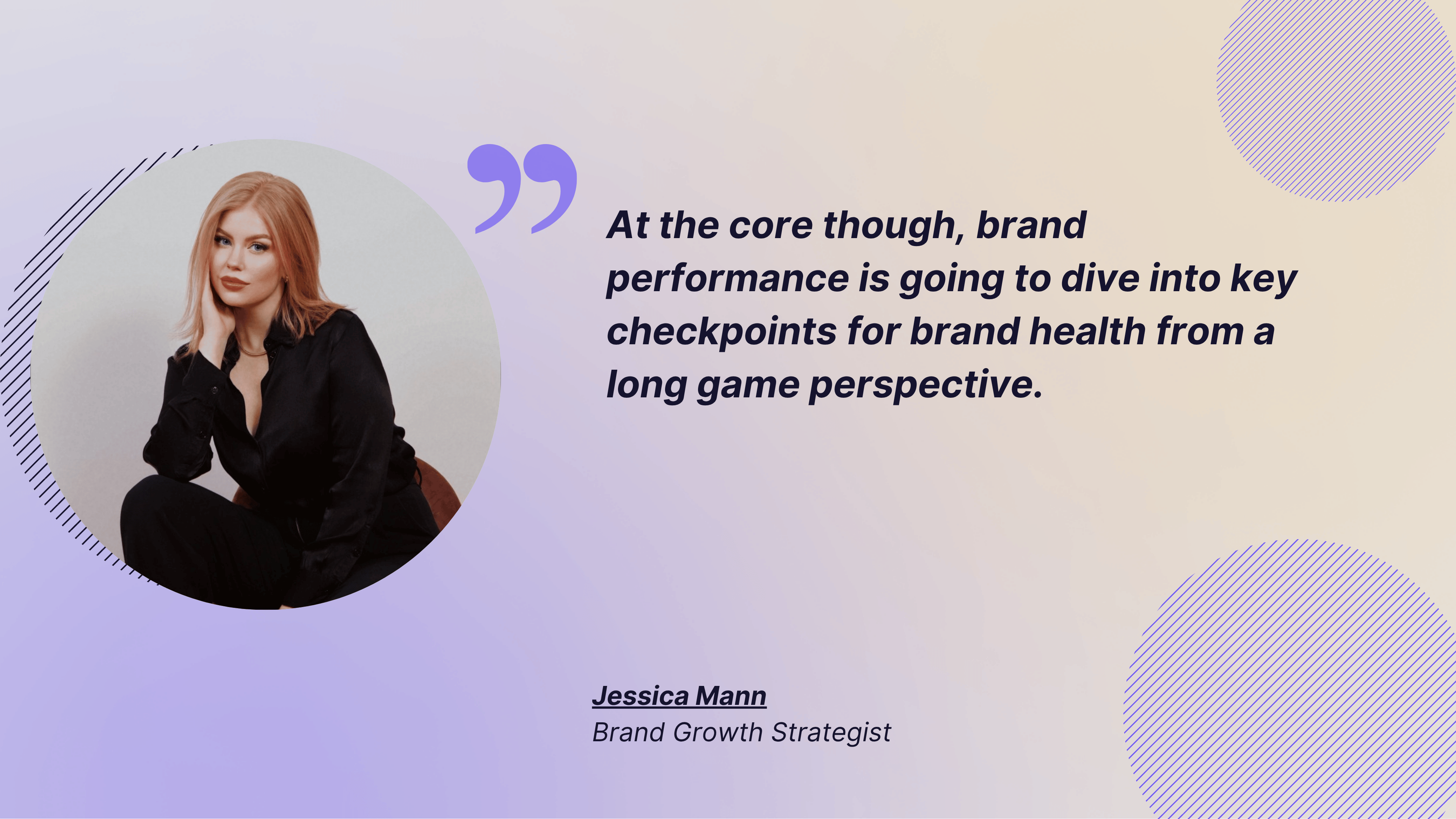
Does brand performance differ from content performance?
Short answer: Yes.
Brand performance is a much higher-level analysis than content performance. With content performance measurement, you’re looking at each individual piece of content on its own, analyzing how your audience received it and if it hit the goals you were hoping to achieve.
Brand performance measurement looks at the overall health and state of your brand as a whole. Instead of analyzing a blog article, landing page, or social media post, or even all of your content together, it looks at the state of your brand.
Here’s how Chelsea explained it:
Content performance looks at how individual pieces of content are doing. Are people clicking, watching, sharing, or converting? It’s very tactical and tied to specific outputs.
Brand performance zooms out. It’s about the overall perception and impact of your brand over time. Brand performance reflects how well your audience recognises your brand and trusts it. It’s less about one post and more about the emotional thread that connects every touchpoint.
That said, they’re connected. Strong content contributes to strong brand performance, but content is the vehicle, and brand is the journey. One helps build the other, but they’re not the same thing.
What does this mean?
It’s important to monitor how your audience perceives your brand, or how they feel about it.
Does your brand name come with good connotations? (Ideally, that’s the goal.)
Are people having conversations about your brand?
Are most conversations promoting your brand or talking about customer service issues they’ve had?
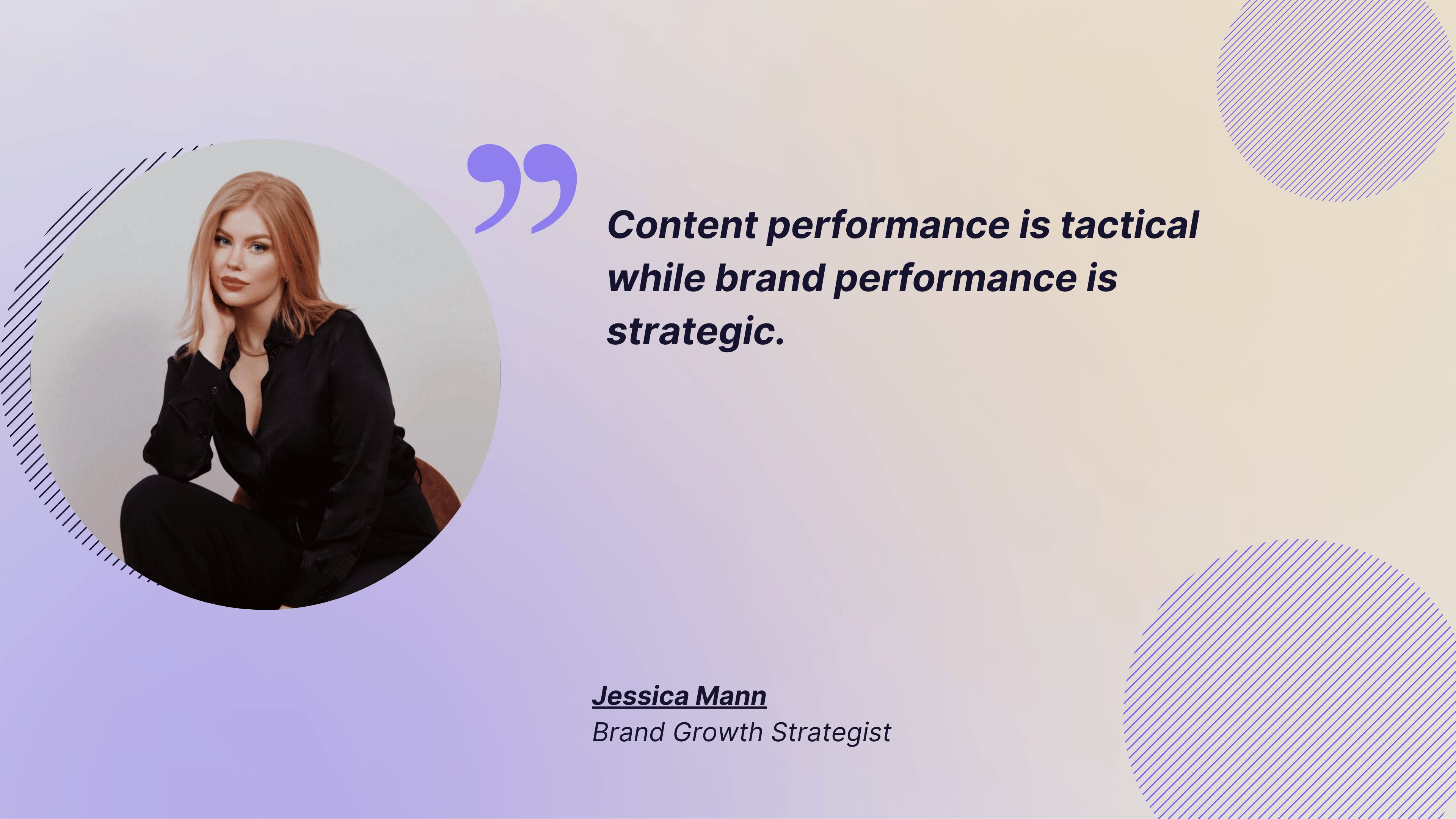
Below are some insights that Jessica offered about some do’s and dont’s when measuring both that I think will be useful.
Focusing on their needs and interests will help you build trust through honest communication, which, in turn, will encourage more meaningful engagement and long-term growth for your community.
Content performance is tactical while brand performance is strategic. If you want to learn how a specific asset is doing, content performance is going to tell you by looking at engagement rates, watch times, saves, audience retention, etc. It gives a very dialled in view point that can help you optimize your content.
On the other side, brand performance looks more broader at how all of the content, campaigns, experiences, and partnerships are shaping the overall perception and equity of your brand over time. Okay sure, you went viral but what use is a video that can go viral if it does nothing for your brand’s perception or attracts the wrong audience.
What are some bust-track brand performance KPIs?
As you set out to track your brand performance, there are several KPIs you need to keep an eye on. Let’s walk through each category of brand performance metrics that you’ll want to add to your monthly or quarterly reporting.
Brand awareness metrics
Brand awareness refers to how well your target audience knows of or can recall your brand. The more people are aware of your brand, the bigger pool of potential customers you have, meaning the better your brand is performing.
To measure your brand awareness, you need to look at individual KPIs like:
- Share of voice
- Brand mention volume
- Reach
Share of voice
Share of voice (SoV) measures how much of the market is dominated by conversations around your brand versus your competitors.
As an example, imagine that within the coffee shop industry, Starbucks and Dunkin’ likely have the largest share of voice, respectively. Keep in mind that this is also likely largely geographical, and areas in Canada may see Tim Hortons with a larger share of voice.
To measure SoV, use the following formula:
Your Brand Mentions / Total Number of Brand Mentions (Yours + Your Competitors') x 100
You’ll end up with a percentage that tells you how much of the industry is talking about your brand. 25-30% is considered a strong share of voice, but this range can wildly depend on things like your industry, the competitive landscape, and other factors.
Brand mention volume
Next, you want to look at brand mention volume. This is similar to measuring your share of voice, except you’re just looking at the total number of mentions your brand gets across all channels—social media, websites, publications, videos, and more.
You can use social listening tools or a tool as simple as Google Alerts to make sure you don’t miss any online mentions of your brand.
Make sure that your brand mention volume is consistently growing month over month, as that will be a clear indicator of a good brand performance.
Reach
Finally, you also want to examine your reach. Reach refers to the total number of people who have seen your content or your promotions within a given period of time. You can use website and social media analytics tools like Socialinsider to help you pinpoint how many people you’ve reached with your brand.
But with brand awareness, you want to look further than just the number of people you’ve reached. It’s important to look at the trends as well, to see if your efforts are consistently bringing more value over time.
Using Socialinsider’s reach analysis, you’re able to look at your total social media reach, plus how it fluctuates over time, so that you can make sure you’re consistently reaching more and more people within your target market.
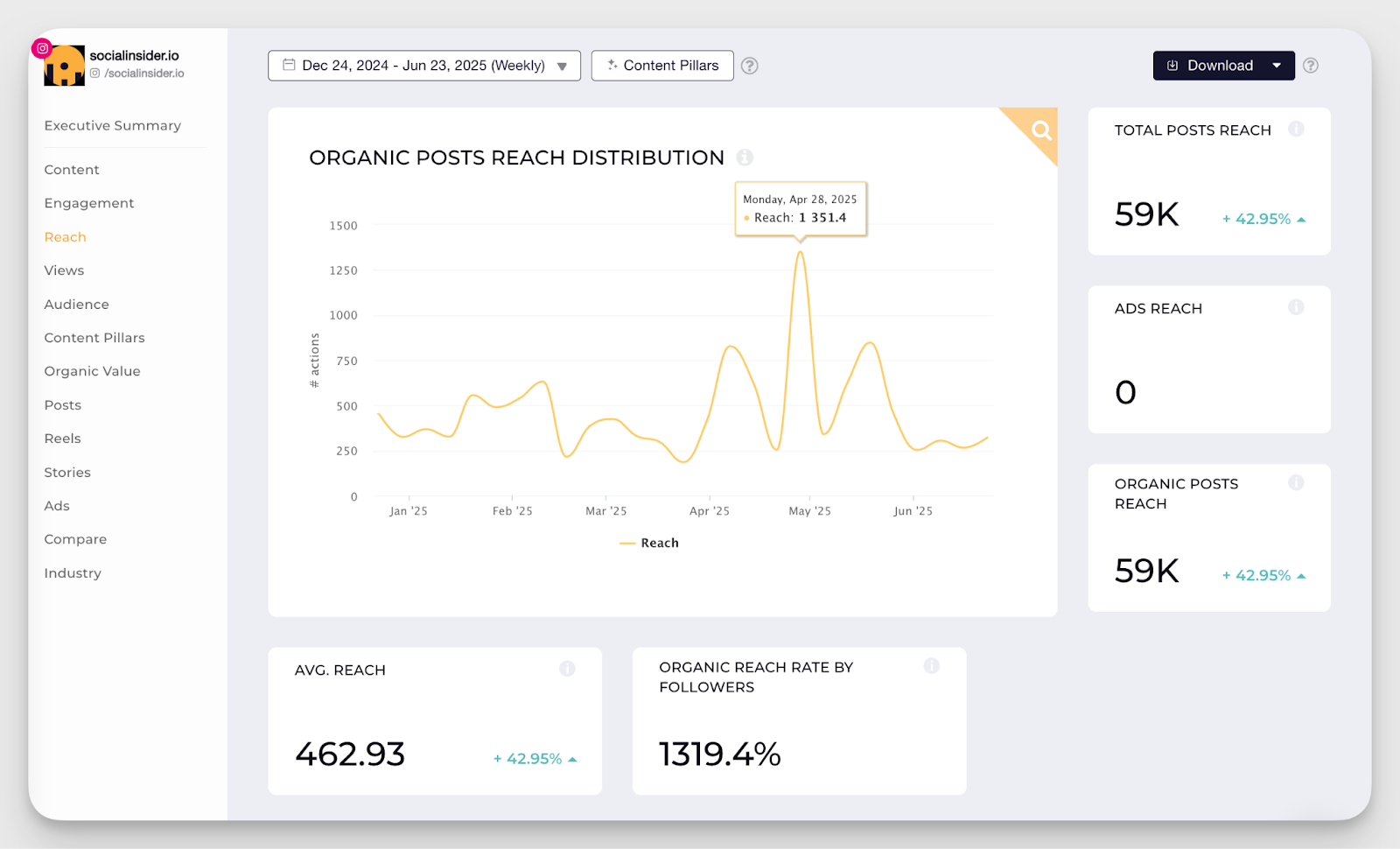
Tracking your brand awareness metrics ensures you get an idea of how well known your brand is within your industry. This lets you know whether you need to be ramping up your promotional strategy to reach more people in your target market or if you’re on a solid growth trajectory.
As a takeaway on this, here’s Jessica’s insight:
The numbers matter, but so does the story behind them. It’s one thing to track clicks and mentions, but the real question is: Are we building something memorable? Something meaningful? That’s what strong brand indicators can reveal when you’re paying attention to both the data and the story it tells.
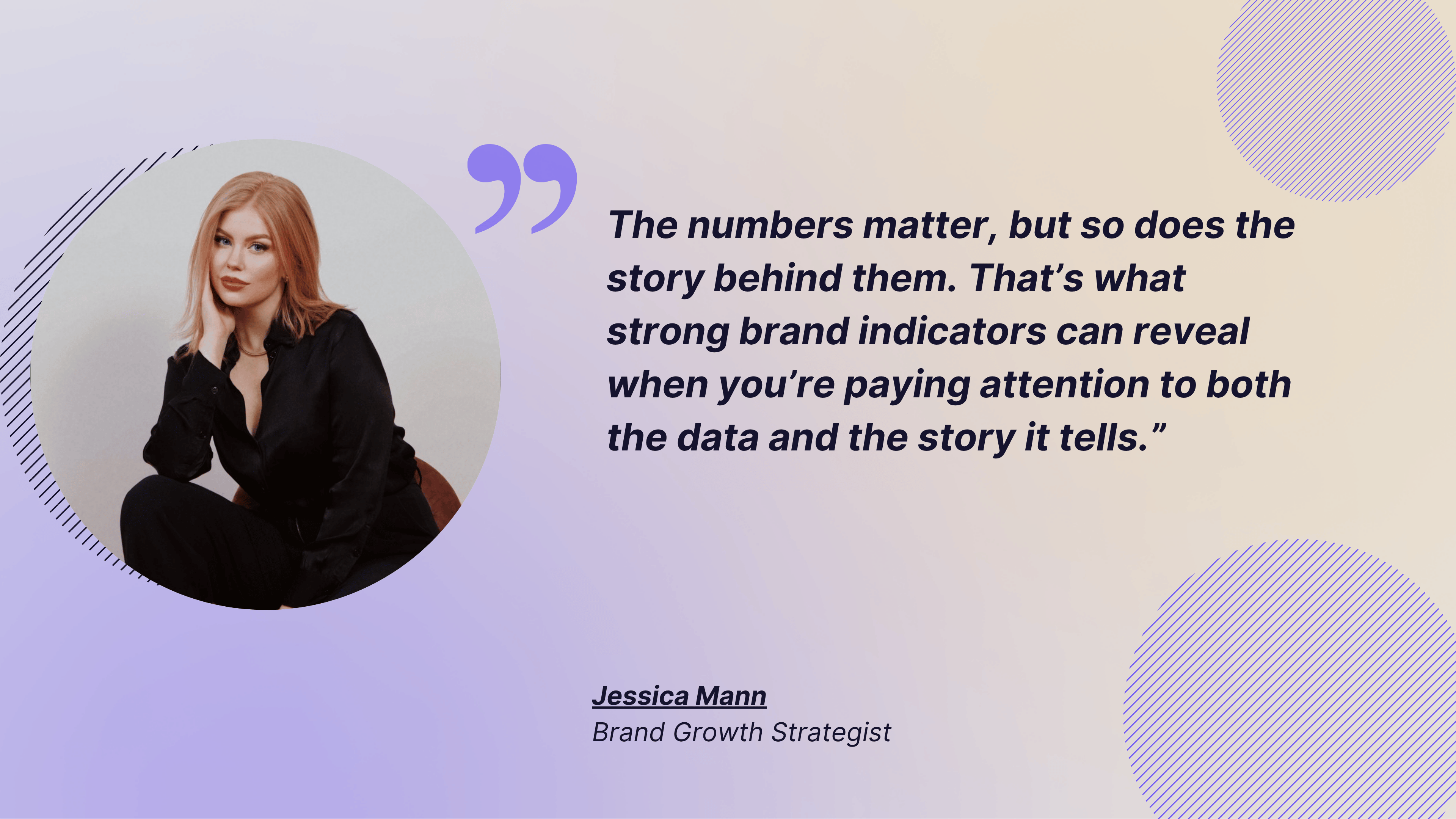
Brand engagement metrics:
Next, you need to look at performance metrics surrounding your brand engagement, or how many people are interacting with your brand online.
These KPIs include:
- Engagement rate
- Comments
- Shares
- Saves
Engagement rate
Your engagement rate measures how many people are interacting with your content. The formula for this metric is:
Number of Engagements / Number of People Reached x 100
Essentially, you’re calculating the percentage of people who interacted with your content after seeing it. You can also use the following formula:
Number of Engagements / Number of Followers x 100
Using that formula would let you know how many people are interacting with your content out of the total number of people who already follow your brand.
This metric tells you how interesting your content is to your target audience. The higher your engagement rate, the better. However, each platform has its own benchmarks you at least want to aim for.
Keep these engagement rate by followers benchmarks in mind as you calculate your own results:
- TikTok: 2.50%
- Instagram: 0.50%
- Facebook: 0.15%
- X/Twitter: 0.15%
Socialinsider gives you an overview of your social media performance. Take a look at this example dashboard below to get an idea of the insights you can get access to:
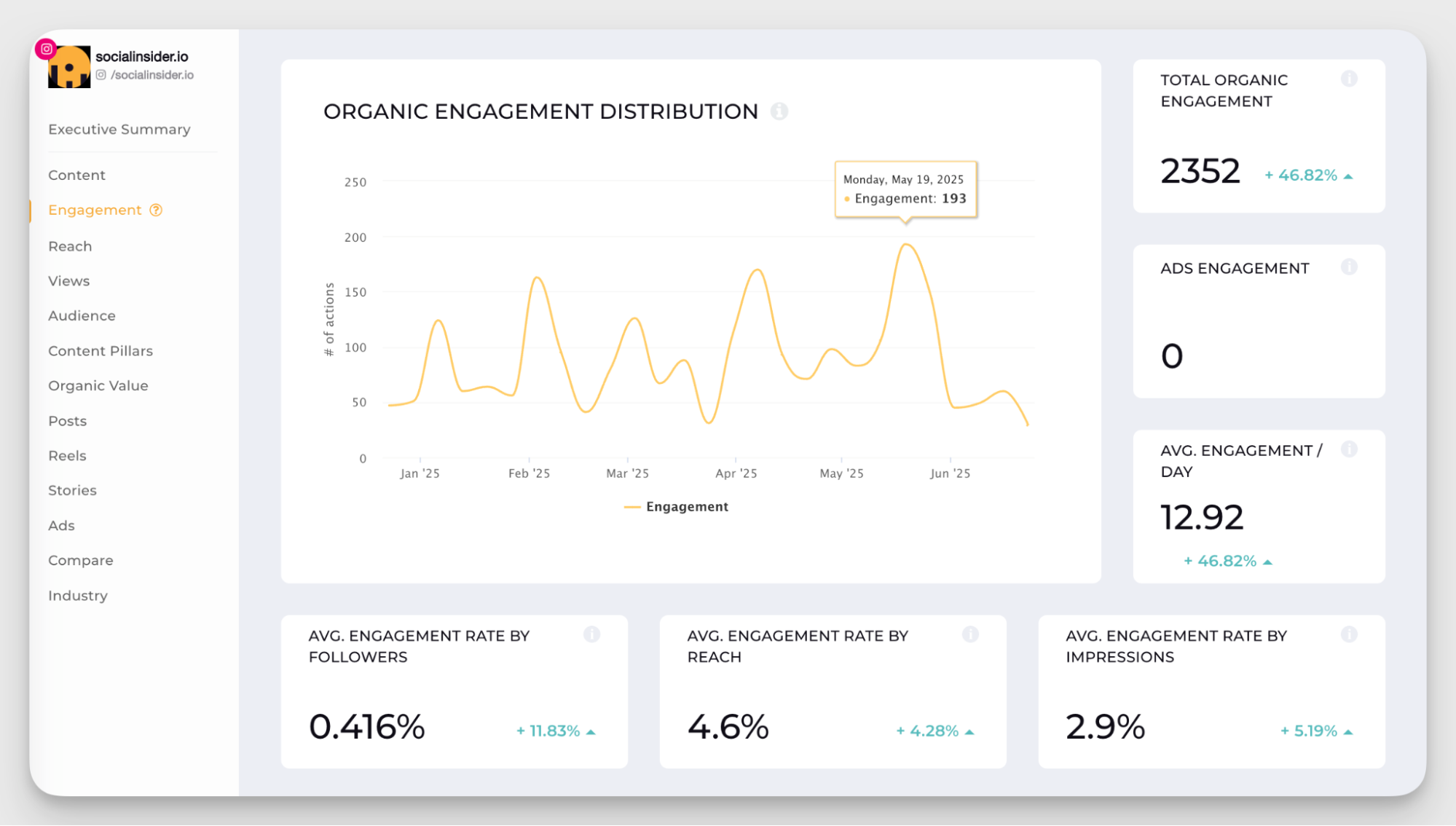
This might seem like a lot of data to track, and yes, it’s still early on, but here’s why all this data is important, according to Chelsea:
When it comes to tracking brand performance, you want to focus on indicators that reveal both the breadth and depth of your brand’s influence.
Key metrics include how widely your brand is recognised (brand awareness), how positively it’s perceived (brand sentiment), and how much space it occupies in conversations compared to competitors (share of voice).
Engagement levels tell you how invested your audience is in your message, while loyalty and retention metrics show whether you’re building lasting relationships.
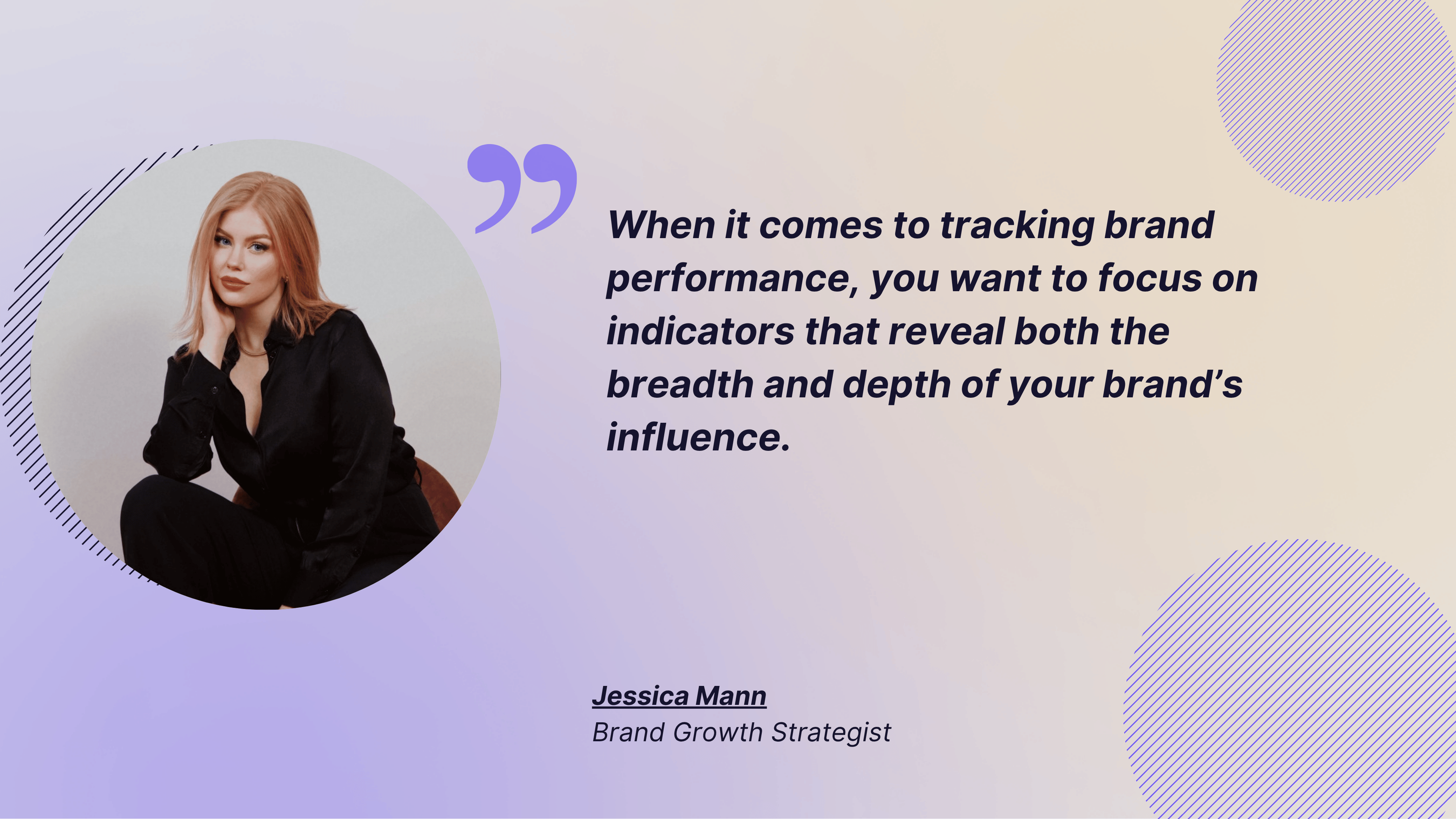
Comments, shares and saves
Your comments, shares, and saves are three different types of engagements that your audience can take with your brand. Likes are also a form of engagement, but that’s an extremely simple one that doesn’t really tell you much. Many users like posts mindlessly as they scroll through their feeds.
However, if your post resonated enough with a follower that they left a comment, shared it with their network, or saved it to go back to later, that tells you a lot more about the type(s) of content your audience wants to see from you.
You can also see this data within your Socialinsider dashboard by scrolling down in the Engagement tab:
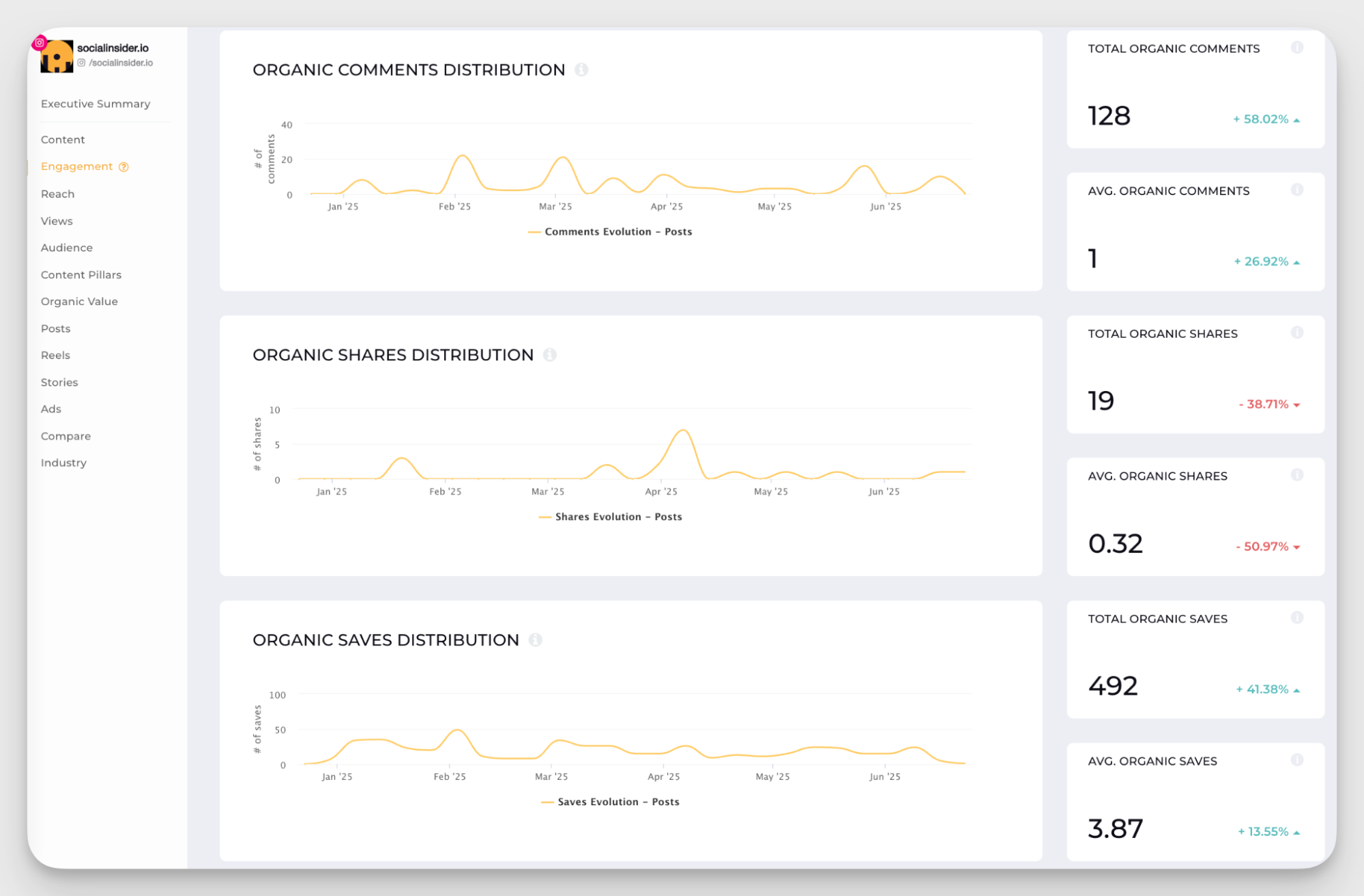
Finally, Jessica adds:
We have to be able to go beyond likes and followers when measuring brand performance. I want to see how the brand is being perceived to our intended audience, is it being remembered, and of course was there enough motivation to take action. I believe this is one of the best ways to really see a brand’s relevance and reputation.
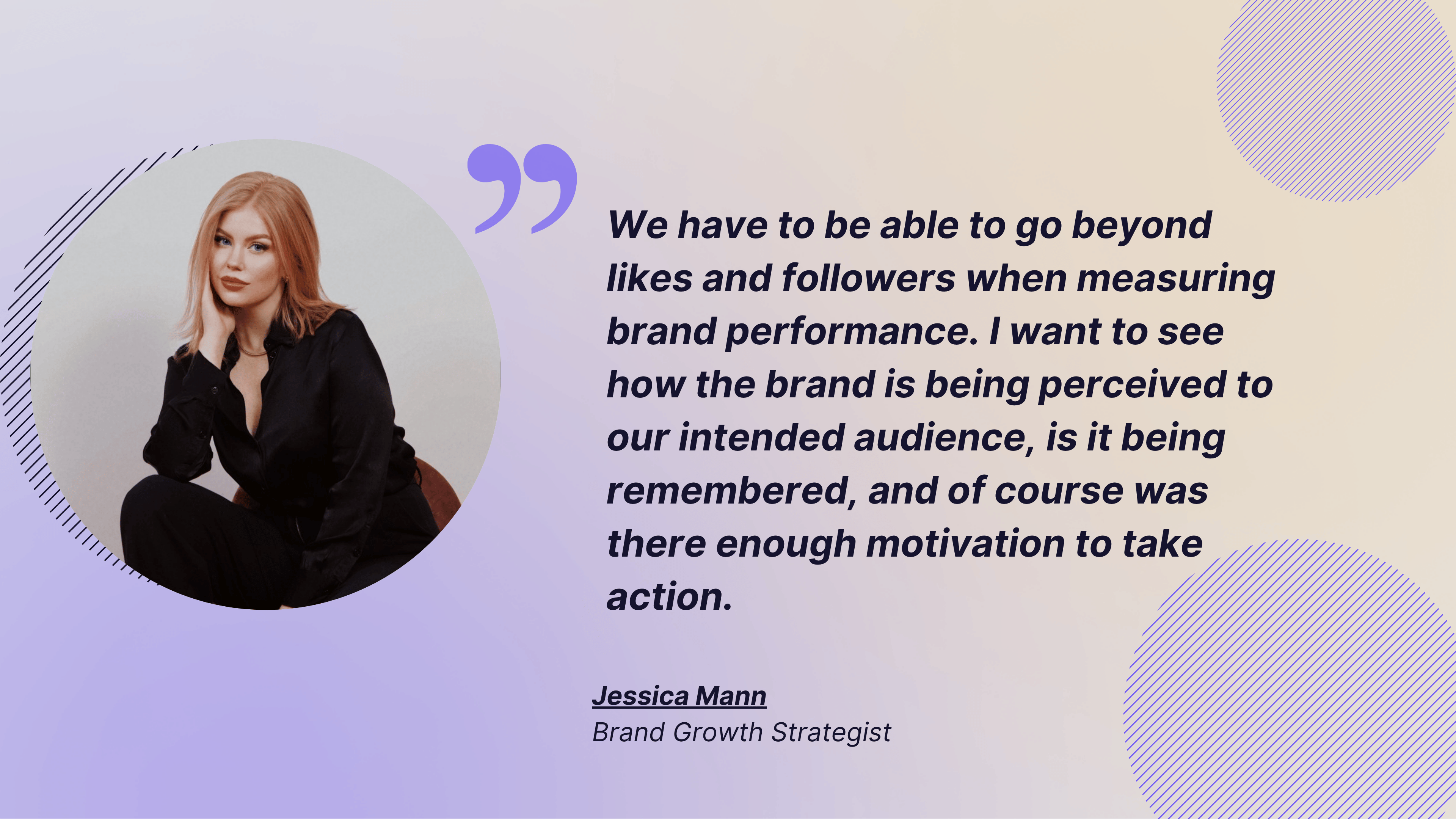
Brand perception metrics
The next category of brand performance metrics is all about brand perception. This relates back to how the general public views your brand. How they feel about your company and its products or services.
The main KPIs you want to track here include:
- Sentiment analysis
- Brand association strength
- Customer advocacy signals
Sentiment analysis
Sentiment analysis looks at the overall sentiment surrounding your brand online and tells you whether it’s positive, negative, or neutral overall. Sentiment analysis tools look at the tone and context of online posts about your brand and put together an analysis based on their findings.
This is an important metric to track as it tells you whether your brand is being received positively within the market or if you need to make a major pivot because your target audience isn’t very receptive to your brand.
Brand association strength
Brand association strength refers to the feelings or ideas that consumers associate with any given brand—and how strong those associations are. For example, Geico has created a strong brand association with its gecko. People who think of the word “gecko” might also think of Geico alongside it due to this strong association.
Brand associations can be anything from feelings to celebrities, founders, slogans, characters, or any other type of idea or activity that reminds consumers of a specific brand. Nike’s “Just Do It” slogan is another example of a strong brand association.
You can use brand tracking tools to find brand associations as well as focus groups and other market research tactics that let you communicate directly with consumers to get their overall thoughts about your brand.
Customer advocacy signals
Customer advocacy signals tell you how willing your audience is to advocate for or promote your brand. This type of advocacy could come via:
- Online reviews
- Word-of-mouth referrals
- User-generated content
- Social media mentions
Customer advocacy is a powerful form of marketing and a sure sign that you have a positive brand perception amongst your audience. To track customer advocacy signals, look at how many reviews your brand is getting online and the number of UGC posts your customers are creating.
One final insight that Jessie gave me and I consider very important to keep in mind when analyzing your brand’s performance is this:
Qualitative metrics are trickier, but arguably more revealing because they’re rooted in perception and help decode how your audience feels. I like to look through the lens of audience sentiment, save to share ratios, brand associations and community depth.
When I see things like “I feel like this was made for me” or “this finally makes sense” or “this made me think of X” we know we’re onto something.
In short, quantitative data validates the impact but qualitative data explains the emotional drivers behind it. You need both to understand how your brand is performing and why it even matters.
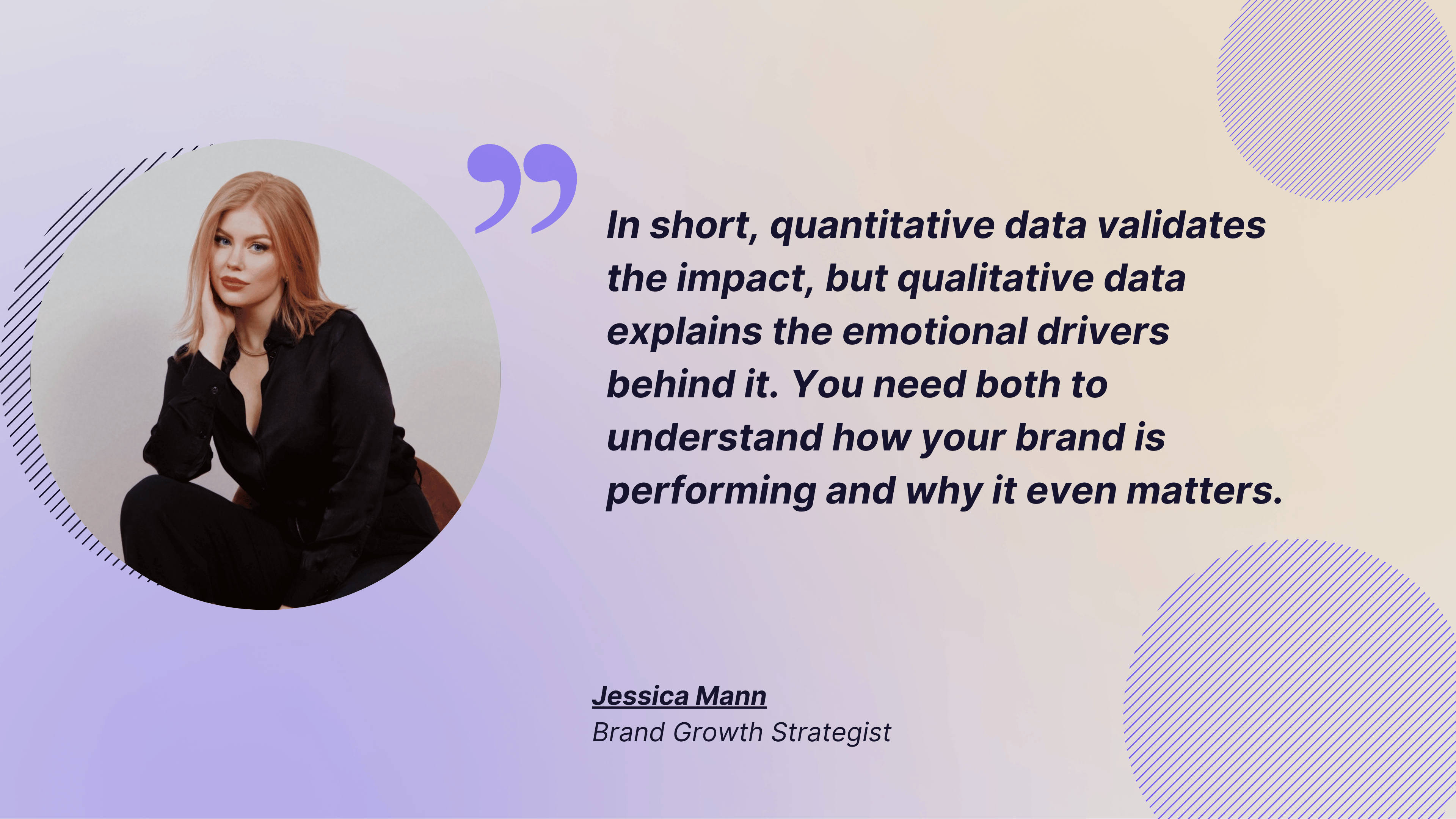
Brand loyalty indicators
Next, you want to look at brand loyalty indicators. These tell you how likely your customers are to keep coming back, remaining loyal to your business and not heading off towards your competitors.
These indicators include:
- Community growth
- Repeated engagement patterns
- User-generated content volume
Community growth
With community growth, you’re looking at the size of your social media community (i.e., engaged followers, group members) and how it has fluctuated over time. You want to see consistent growth, showing that you’re adding more engaged customers to your audience.
Repeated engagement patterns
Repeated engagement patterns refer to people who consistently engage with your content and your business on social media. You want to see these repeat engagement patterns as it shows you that your brand and your online presence is resonating with your target audience, and that they’re regularly wanting to see and interact with your content.
When looking for repeat engagement patterns, you also want to analyze the different types of content that tend to see the most engagement. This can help you optimize your content with the top-performing formats or topics.
You can access this within your Socialinsider dashboard by scrolling through the Engagement tab until you find the graph showcasing post types sorted by engagement, like in the example below.
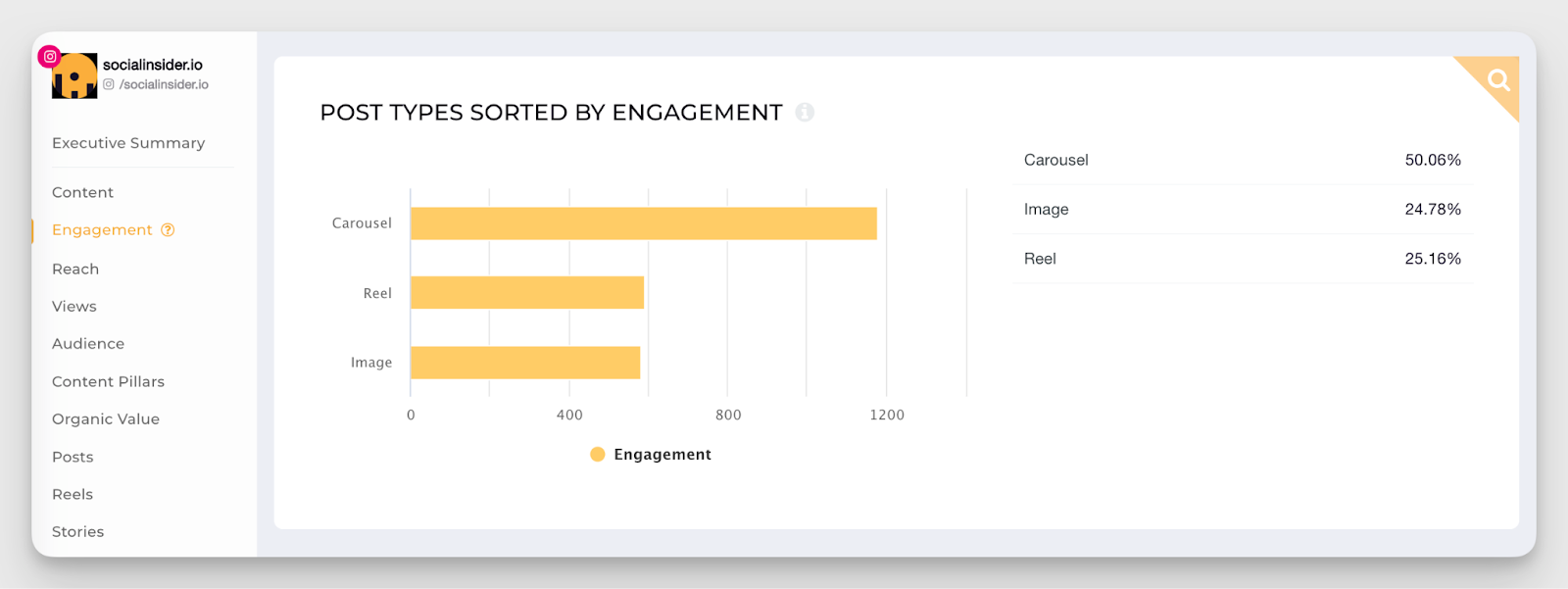
You can also check out your content pillars—the topics you post most about—to see which of those outperform the rest. This can help inform your content calendar going forward, so you can continue to increase repeat engagement.
User-generated content volume
And finally, you can also look at user-generated content volume. User-generated content is content that your audience has created, but that you can cross-post and use as your own marketing content. It helps your strategy feel more authentic and showcases that you have a wide range of happy customers.
The more UGC you see your customers post, the more likely it is that you’re generating loyal and happy customers that will continue to buy from your business.
Brand authority metrics
Your brand authority refers to the level of trust and credibility you’ve built within your industry. Do your customers trust you? But more than that, are you considered a leader amongst your industry?
To gauge your overall brand authority, you want to monitor KPIs like:
- Industry mention share
- Expert citations
Industry mention share
Industry mention share is similar to share of voice (SoV), but is a bit more specific. Instead of looking at your overall visibility within your industry, it hones in on just your online mentions. This tells you how authoritative your brand’s voice has become across your industry.
To calculate this, use the following formula:
Your Brand Mentions / Total Mentions in Your Industry x 100
This lets you see how much of the industry conversation your brand is dominating. A high authority brand will obviously be talked about a lot. And a high authority brand is a key indicator of a successful brand performance.
Expert citations
Expert citations are online posts where experts mention your brand, either in a blog article or a social media post. The more expert citations your brand gets, the higher its authority, as well.
Here’s an example of what this can look like. The below LinkedIn post is from an industry expert citing Socialinsider’s founder Adina Jipa as the two of them talked through analytics and data. Getting mentions and opportunities like this is a clear sign of brand authority.
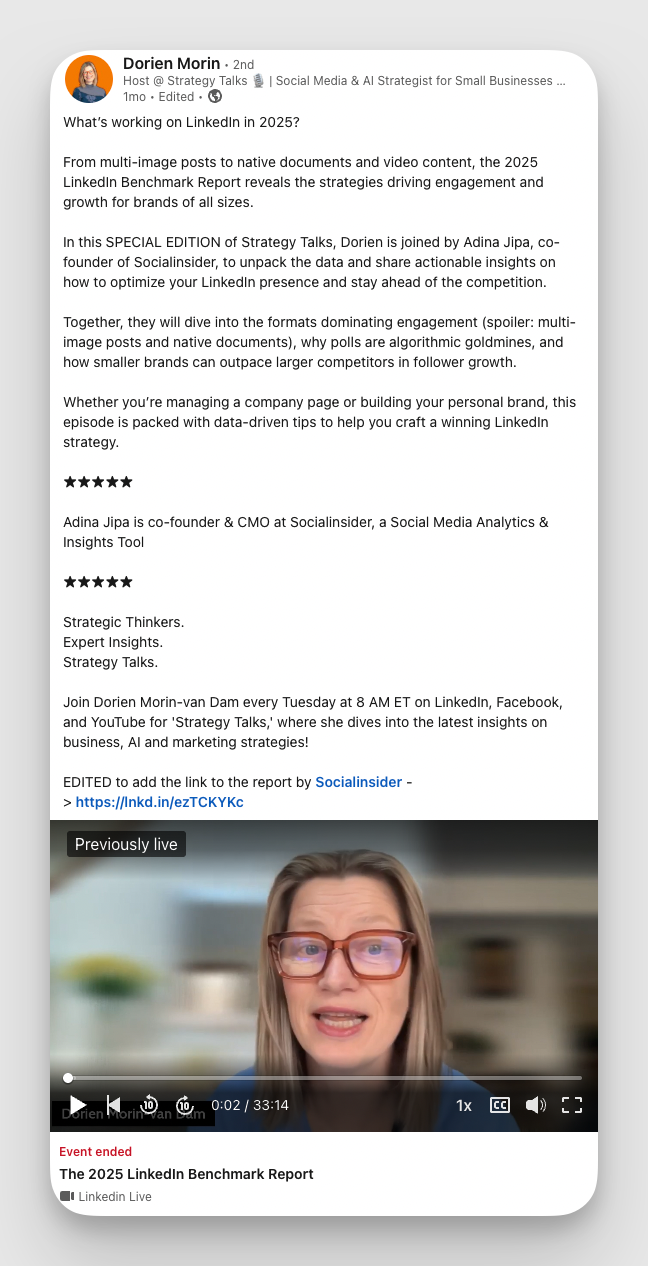
Competitive brand metrics
Finally, we need to look at competitive insights, or KPIs that showcase how your brand stands up against its competitors, to round out your brand performance analysis.
The main metrics you’ll look at here are:
- Engagement rate comparisons
- Audience overlap analysis
Engagement rate comparisons
Engagement rate comparisons measure your own engagement rate up to your competitors’ engagement to see how you line up. You can easily access this information inside your Socialinsider dashboard by adding all of your major competitors to your account.
Take a look at the overall profile summary below—you get to see comparisons for follower count, overall engagement, number of posts published, and overall reach. Use these numbers to calculate engagement rate for both your brand and your competitors to see where you stand.
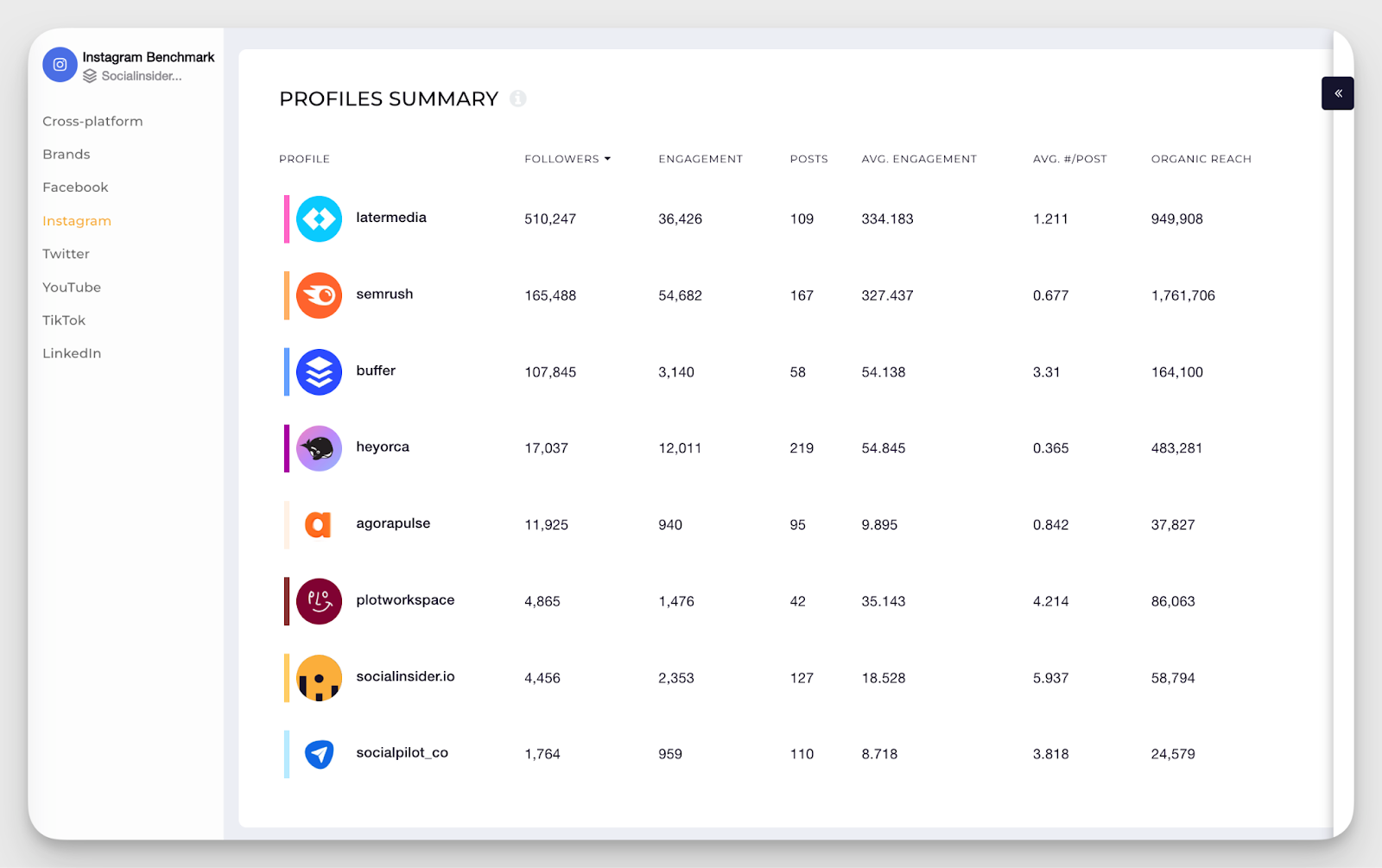
Audience overlap analysis
Audience overlap analysis shows you how much of your audience lines up with your competitors’ audiences and how much of your respective targeting overlaps. You can use audience overlap tools to measure this metric and discover your closest competitors.
Once you’ve found those competitors, you can more easily conduct competitive benchmarketing analysis, looking to see how you and your performance compare to your closest competitors.
As Aiden from LS Electric, one of our customers told us in a customer interview, when asked about why did he signed up for Socialinsider: "You need some platform to analyze how we are doing and where we are at and what should we do to overcome or to follow our competitors."
Brand performance measurement techniques
Aside from tracking the aforementioned metrics and KPIs, there are a few additional techniques you can employ to measure your overall brand performance.
- Emotion analysis and brand sentiment measurement: Use social listening and sentiment analysis software to analyze the overall emotion surrounding your industry, and more specifically, your brand. Understanding your target audience’s emotions behind their motivations to buy can help you create better messaging and improve your performance.
- Competitive content gap identification: Pay attention to the types of content your competitors are using to ensure you aren’t missing any key promotional ideas. By using Socialinsider’s content pillars feature, you can see the most engaging content pillars for your competitors, and the results generated, offering insights for new content strategies approaches.
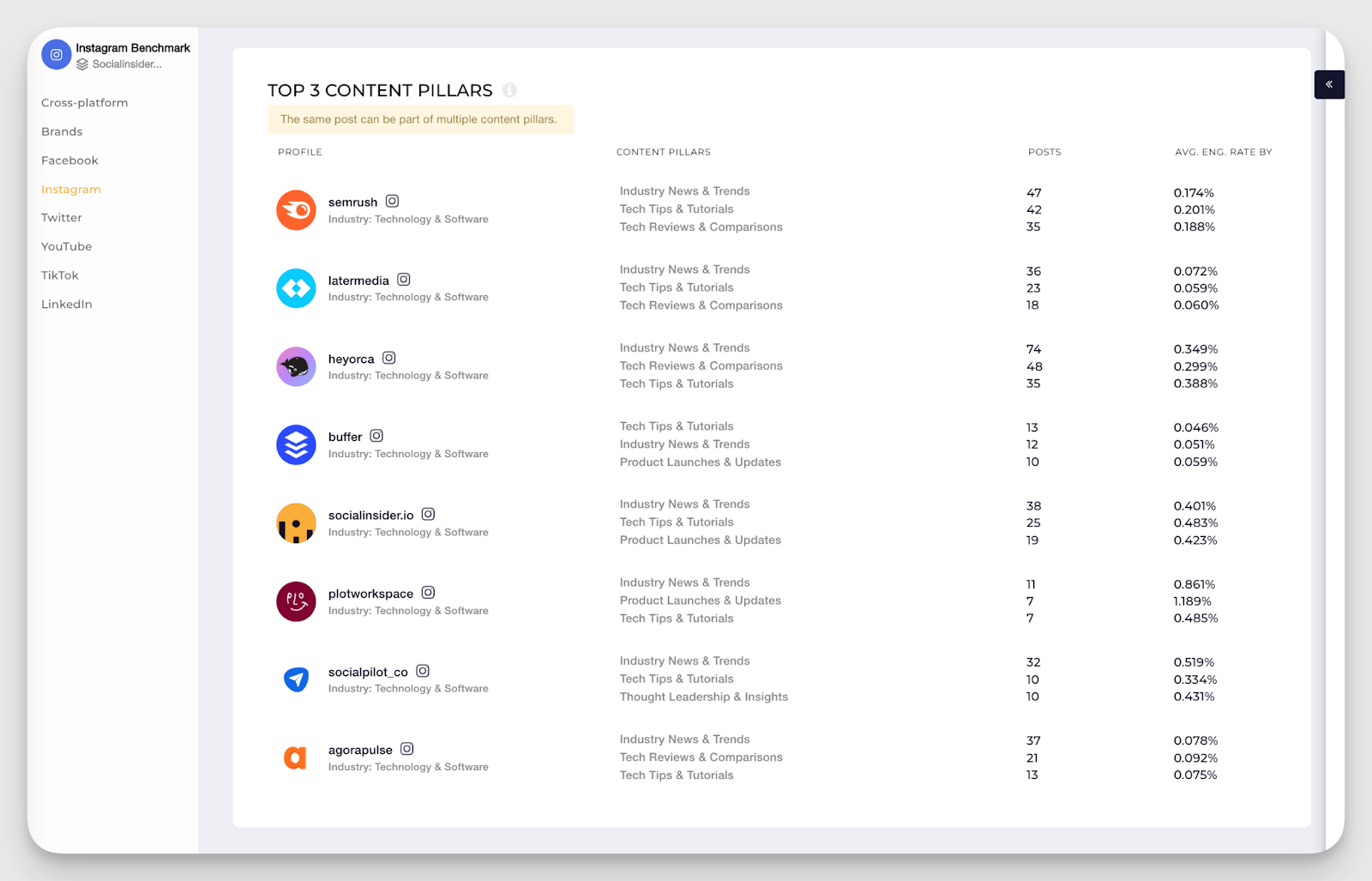
- Cross-platform brand journey mapping and optimization: Analyze how your audience is interacting with your brand across different channels by mapping out all of the touchpoints. Are there places where your audience members are falling off and not making it all the way to becoming customers? Optimize those touchpoints to improve overall performance and conversions.
Tips on how to optimize your brand's performance
As a marketing leader, optimizing brand performance means thinking beyond tactical fixes—it requires a holistic, strategic approach that aligns every brand effort with your organization’s big-picture goals. Here’s how you can orchestrate true brand excellence:
1. Unite your data across functions
Break down silos and connect the dots across every customer touchpoint. Integrate social, web, paid media, and offline data for a single source of truth. Use consolidated dashboards to monitor brand performance holistically—helping you spot trends, identify risks, and find new growth opportunities in real time.
#2. Benchmark relentlessly
Don’t just measure progress in a vacuum. Regularly benchmark your brand’s health, share of voice, and perception against key competitors and industry standards. Use these insights to identify gaps, highlight your strengths, and inform your next strategic move.
#3. Tap Into Predictive Analytics
Leverage advanced analytics to anticipate market shifts and audience behaviors before they happen. Machine learning and predictive tools can reveal leading indicators of brand health, helping you invest resources proactively and minimize surprises.
#4. Build a Data-Driven Brand Culture
Empower your teams to make decisions rooted in data. Encourage sharing of insights at every level of the organization, from marketing to sales to the boardroom. Transparency and education around brand metrics foster accountability and drive collective buy-in for your brand vision.
#5. Audit and Evolve Your Messaging
Consistency is key, but so is relevance. Regularly audit your messaging across channels to ensure alignment with your brand’s core values and audience expectations. Use social listening and feedback loops to adapt your messaging in real time, keeping your brand both authentic and agile.
#6. Embrace Agile Experimentation
Encourage your teams to test, iterate, and innovate. Frame brand campaigns as experiments with clear hypotheses and defined success metrics. Scale the initiatives that drive results, and swiftly evolve or discontinue those that don’t.
Tools and technologies for brand performance measurement
Lastly, to ensure you’re properly monitoring, measuring, and optimizing your brand performance, you need the right toolset. These four tools can be a huge help.
Cross-channel analysis tools - Socialinsider
Social media analysis tools are key for tracking data like:
- Reach
- Engagement
- Competitor performance
- Social media insights
With Socialinsider, you can get access to key competitive analysis features that let you in on how your social media marketing performance lines up with that of each of your main competitors.
You can also get access to data that helps you form an informed paid campaign budget by looking at the overall organic value of your results:
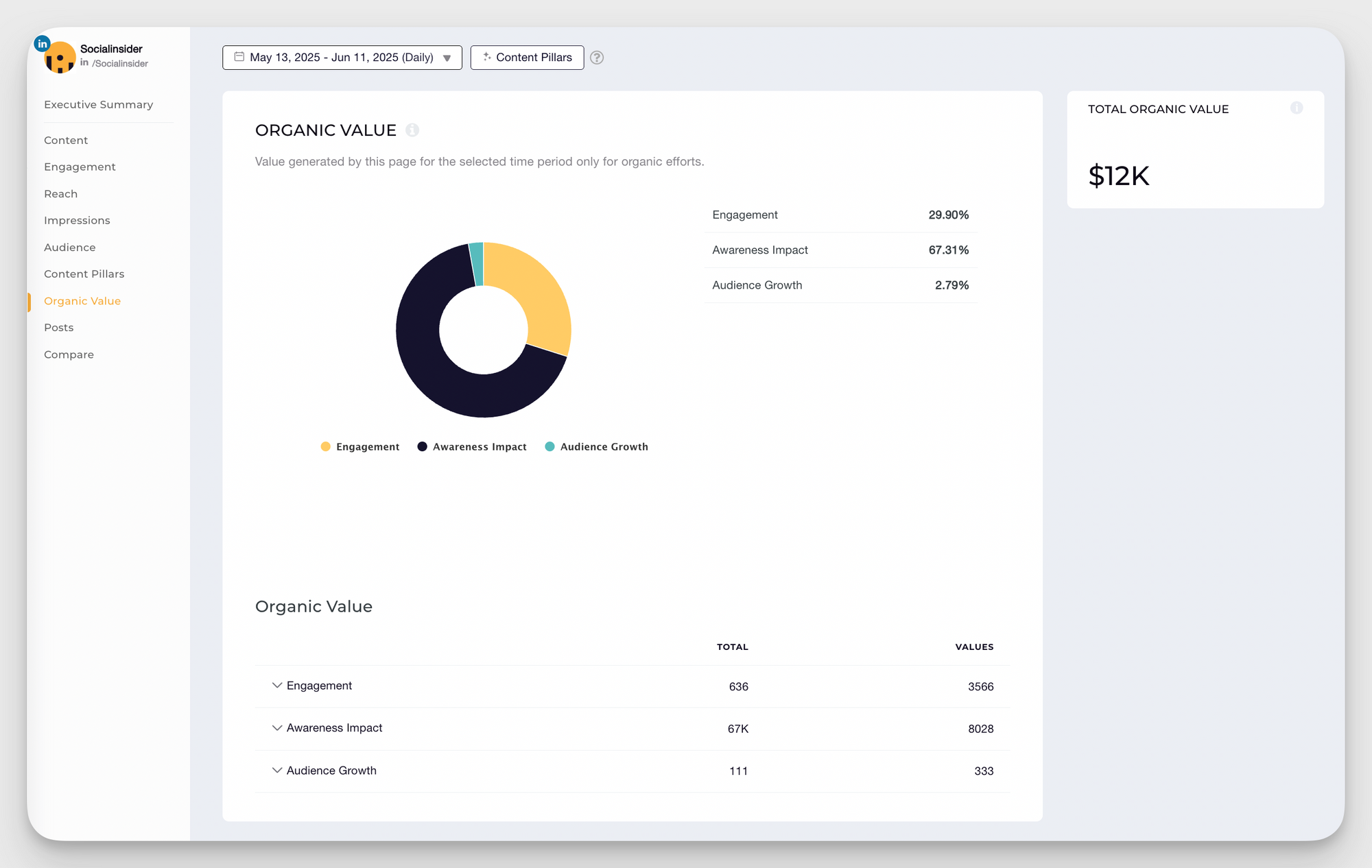
To access this on your own, we recommend configuring the values based on the benchmarks of your industry.
Start by clicking on Settings from your home dashboard, then click on Organic Value Configuration.

From there, choose the channels you want this metric calculated on. Next, you can assign different values based on what engagement, awareness, and other metrics are worth to your business.
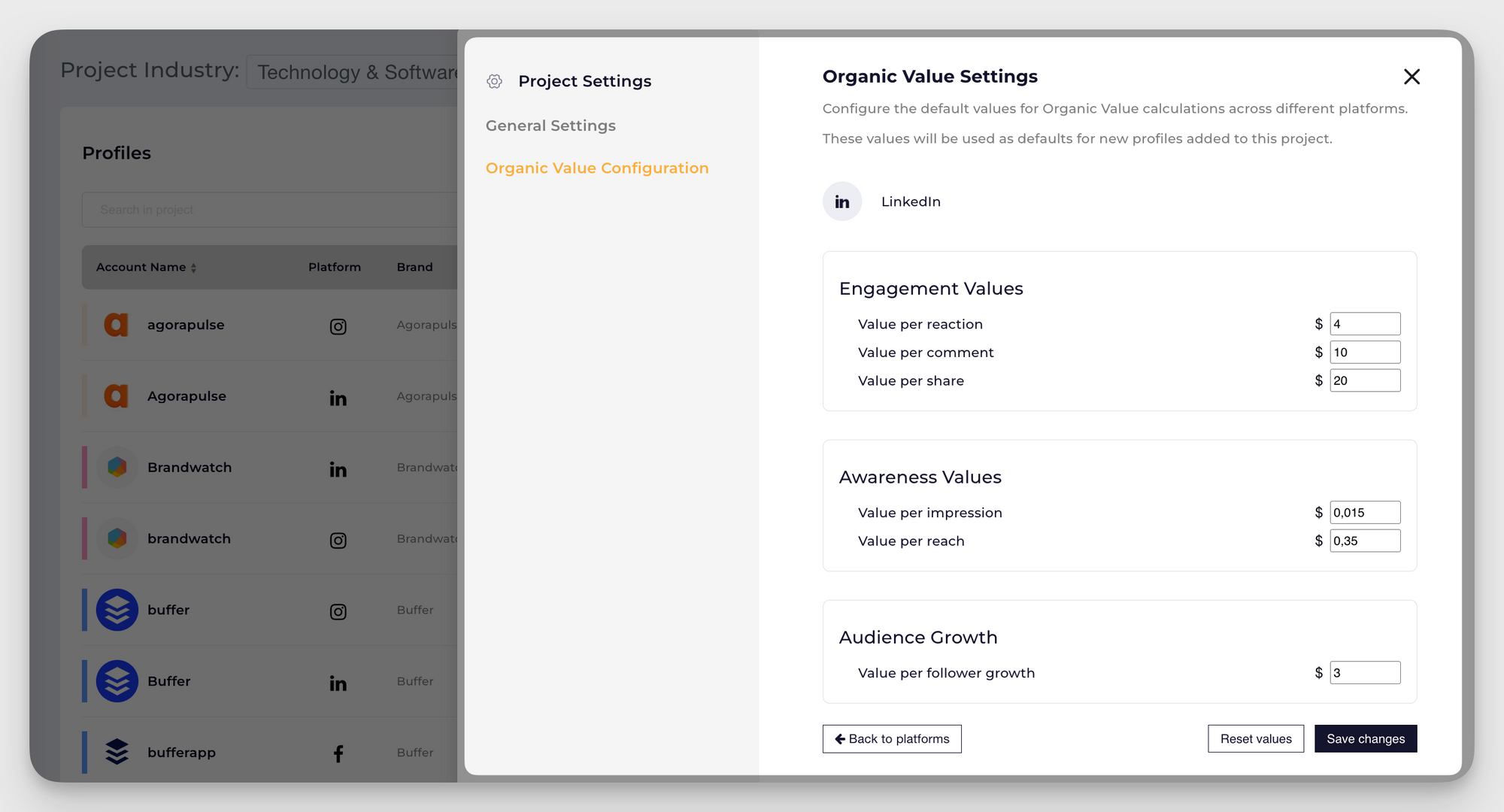
Socialinsider can also help you track the overall performance of each of your social media channels, monitoring growth over time and ensuring your social media strategy is improving your brand performance.
And just in case you're not totally sure whether you should test out Socialinsider, just yet, here's how Chris from Axel Springer, one of our customers, reviewed our platform: The user interface and just the general UX with it is quite straightforward, which compared to the complexity of other ones is much appreciated."
Social media monitoring and listening tools - Mention.com
Social media monitoring and listening tools can help you track metrics like:
- Brand mentions
- Share of voice
- Sentiment analysis
- Brand association
Mention.com is a great tool to check out for online monitoring and analysis.
You can get access to features like real-time monitoring of online data across the last two years, sentiment analysis, share of voice, competitive intelligence, and more.
SEO tools - Ahrefs
SEO tools play a major role in your content strategy. They can help you find the right keywords and topics to create content around, while also helping you analyze your audience overlap and content gaps.
Ahrefs is a go-to SEO tool for brands looking to use their content strategy as part of their brand performance optimization.
Get access to features that help you explore competitor websites, find gaps in your content topics, track content performance, and more.
CRM - HubSpot
A CRM is essential for tracking data about your customers. You can use your CRM to monitor metrics like:
- Sales
- Repeat purchases
- Customer interactions
HubSpot has a free CRM that houses all of your customer data in one easy-to-access place. You can use the CRM to gather customer information like contact info to then market directly to them via email and text.
You can also get access to features that let you track your customer relationships, sales, and other activities.
Final thoughts
For me, a strong data analysis framework isn’t just about staying on top of results—it’s about leading with clarity.
By sticking to proven expert tips and always adapting my process to new business challenges, I make sure performance insights drive every big decision.
My advice? Trust your framework, revisit it often, and let it be the tool that helps you stay agile and ahead.
FAQs on brand performance
How to set a data performance analysis framework?
- Define your business objectives: Clarify what you want to achieve (e.g., brand awareness, sales growth).
- Choose relevant KPIs: Select metrics that directly measure progress toward your goals.
- Integrate key data sources: Combine data from social, web, CRM, and sales for a holistic view.
- Set benchmarks and targets: Compare your performance to past results and industry standards.
- Build clear dashboards: Visualize your KPIs for fast, easy monitoring across the team.
- Analyze trends and drivers: Identify what’s impacting your metrics—positively or negatively.
- Turn insights into actions: Use findings to guide strategic decisions and improvements.
- Review and refine regularly: Update your framework as your business and data evolve.
Analyze your competitors in seconds
Track & analyze your competitors and get top social media metrics and more!
You might also like
Improve your social media strategy with Socialinsider!
Use in-depth data to measure your social accounts’ performance, analyze competitors, and gain insights to improve your strategy.




